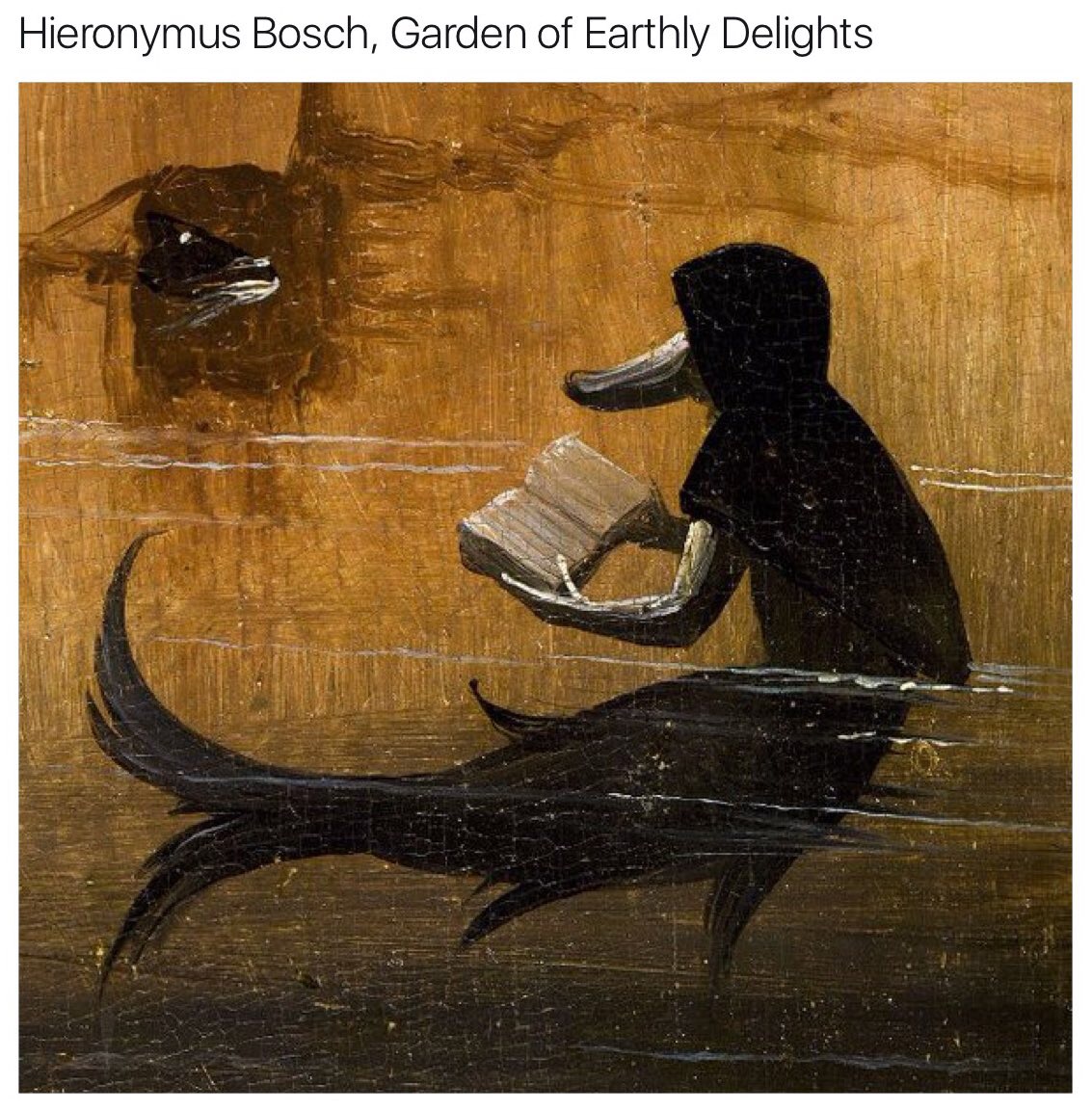
THE DRAFT RESOURCES CREATURE
Performing Medieval Narrative
Bestiary.ca
PRIMARY READING
mss online, projects, libraries
bookshelf (use as mini-library in office, for office hours reference and short-term loan; move books back from home)
OCCITAN
Guilhem de Peitieus, cat poem
Marcabru, La rana chanta
Guilhem IX, Farai un vers, pos mi sonelh
Bernart de Ventadorn / Uc de Saint Circ (?), razo + Quan vei l’alauzeta mover + Zink on it (+ poetic knowledge, birdsong, skin projects)
Breviari d’amor
(other Occ + dolce stil nuovo)
FRENCH
Brendan
Marie MSS: Lais, Fables
Chrétien de Troyes, Arthurian Romances, esp. Yvain
Roman de Renart, Ysengrimus
Roman de Fauvel (+ music)
Arthuriana and woman as animal other
hagiography (in all langs)
ITALIAN
St Francis
Hunting & falconry treatises, allegory, myth, good government, education/training (pair a bird of prey reading with this and with Montaigne on education)
Wolves in Dante & Boccaccio; Botticelli
Brunetto Latini
SPANISH
Isidore of Seville, Etymologiae; Pliny
Calila e Dimna (1252 trans Panchatantra > Persian > 8th c Ibn al-Muqaffa Arabic Kalila wa Dimna > 10 th c Syriac > Simeon Seth 11th c Greek, Abu-l-ma’ali-Nasrullah 12th c Persian, Alfonso X and 1251 Spanish, later Latin, German, and others)
https://archive.org/details/earliestenglishv00doniuoft/page/n12
https://www.zora.uzh.ch/id/eprint/17989/1/CalilaV.pdf
Rocinante and Sancho Panza’s donkey
Sor Juana Ines de la Cruz
ROMANCE
(Ovid & other Latin & earlier, inc Aristotle and fables)
animality, De Anima, animalibus
materia medica
Bestiaries (FR, IT, SP)
Fables, fabliaux
Golden Legend
Medievalpoc
MARIE DE FRANCE
International Marie de France Society
+ Wikipedia
MONTAIGNE
The Montaigne Project
+ Wikipedia
COMMENTARY
A long early stage of designing this course, earlier in 2019, was the gathering of ideas for what readings to include; the materials, imaginatio, and topoi feeding inventio. Wool-gathering increased in woolliness, turned into several lists, scribblings in a notebook, post-it notes appearing stuck to things around office and home, precious backs of envelopes, and so on.
In July I collected these together, transcribed them here, and threw a lot of stuff out. This “resources” page then turned into a “draft resources” page in August, as the course went into the design stage of translating The Stuff into practical terms. Thirteen weeks, feasible work for actual live humans, and with accessible reading. That is: cheap (and widely available second-hand, in good solid editions) and aiming for quality over quantity. With an idea of quality that’s more literary than anything else: qualitatively subjectively critically judged by a human subject; of art whose principal medium is words, words that are poetically rich and deep and dense and beautiful; fundamentally poetic and mythopoetic works that open gateways into wonderful worlds, including that of readers’ creative and critical imaginations; works that share and spread poeticity.
Even in the most intensive graduate course, you can’t read everything. And in no undergraduate introductory “survey” course can you expect to either; the best hope would be to come of out of the course with some sense of what is happening in a curious alien world, and a continuing sense of curiosity and wonder that will move you to read more, to visit again, to spend more time there and perhaps, walking lightly and respectfully, to inhabit this world. And so, back in May when submitting course reading lists to the UΒC Bookstore for them to order in copies in time for September, I had narrowed down the required readings to two: Marie de France’s Lais and Montaigne’s Essays. This present page of readings / resources was a woeful sigh about all the books that I wished that I’d been able to ask the students to read—had we had more hours per week, had they had fewer courses and fewer other commitments, had it been reasonable to do that much reading, had it been possible to do so in depth and with due attention and treating the readings themselves with the dignity and respect that they deserved—and this page was also an optimistic “ooh” of joy: supplementary readings to complement the required ones. At that stage, I’d been thinking that, for student independent projects, this could be a list of suggestions from which students would take one of these readings and work on it in relation to the course theme and the two set texts.
Reading this draft page now in November, at the end of the course, I’m seeing how it fits better in this site’s structure and navigation: not where it was before, with the course syllabus and assignments and so on. Here’s what the course site looked like back in July:
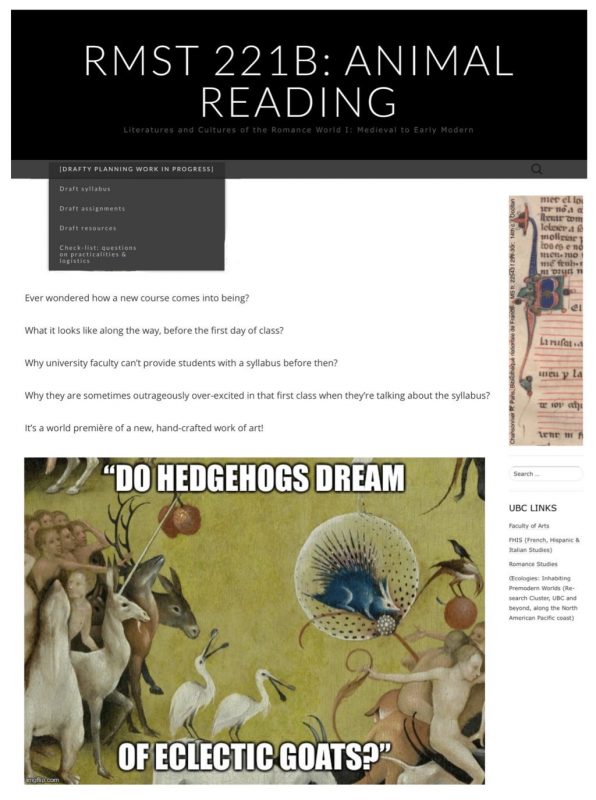
The Blog Site Creature (a relative of the other creatures in this story) has grown and moved around and cogitated between July and September and November. In the beginning, we had a single centre, a traditional canonical core:
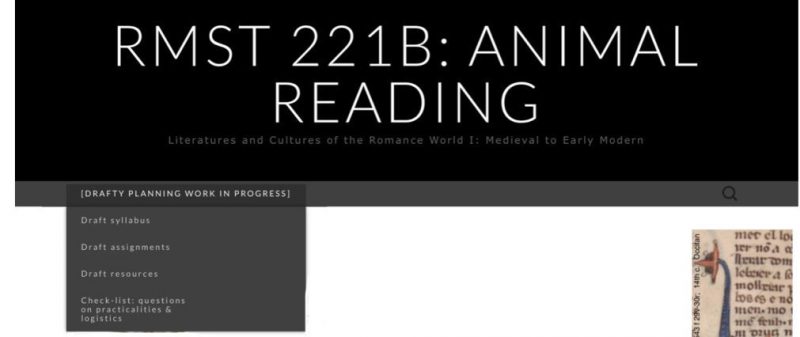
A single organisational menu became four, and the syllabus moved away from the start and the centre …
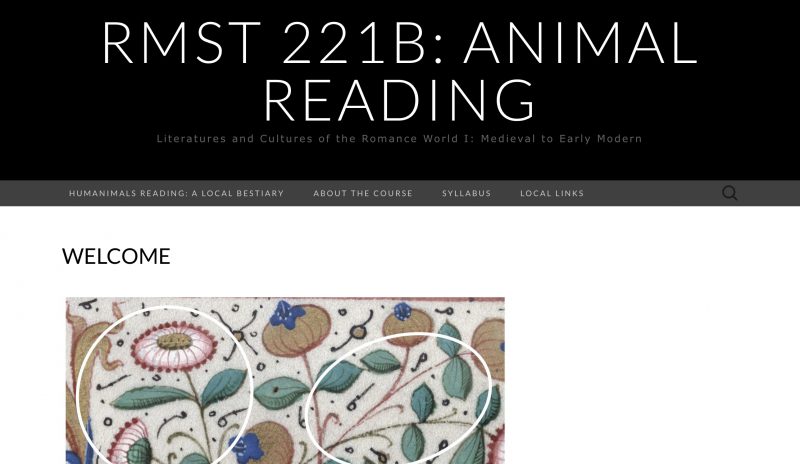
… and then there was more growth, or rather, offshoot growths that branched off and sprouted twigs and leaves …

… and this present page moved too. It’s the only one that’s kept its drafty nature: the other July draft pages have either been persuaded to hibernate (“check-list: questions on practicalities & logistics” is dormant) or turned into fixed static pages (“syllabus,” “assignments”). Some, as you see above, with further new growth. Keep that idea of draftiness in mind; I did for some time, unsure what to do with it, but with a niggling sense that pruning, or amputation or killing, was wrong. (We’ll return to the drafty nature of this draft page in a moment.) Between September and November, it wriggled uncomfortably; it’s now gone to live with the course prologue, as an epilogue:
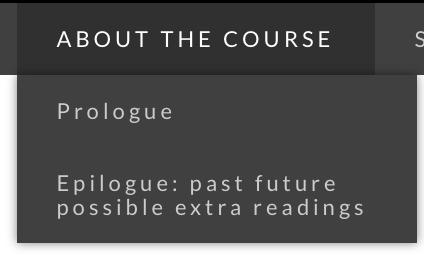
Meanwhile the bestiary—and all its associated free online resources, including digitised medieval manuscripts—became increasingly central:
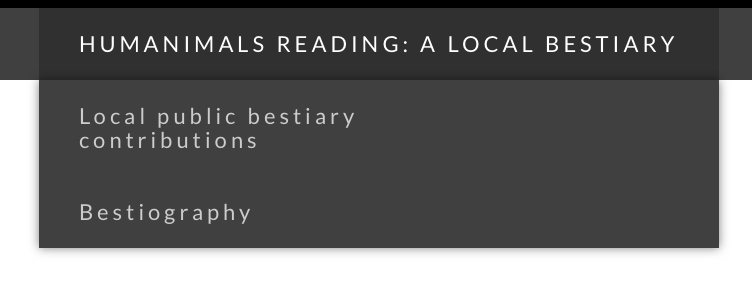
A course is a living thing; creature or ecosystem or world, or monster, depending. And it’s haunted by its previous states of being. I wanted to preserve some record of its prehistory and previous selves, in thinking about its possible futures and teaching it again (or its kith or kin or offspring). The original notebook remains, and it now contains the remaining post-it notes and other archaeological scraps and musty relics. It looks like it’s eaten them but hasn’t digested them yet, they’re sticking out around the elastic band holding the whole thing together. Material for future cannibalisation here too. Here are some pictures and a description of work in progress at the July stage.
I’ve left this page in its July state, except for two things. There was one small change in August
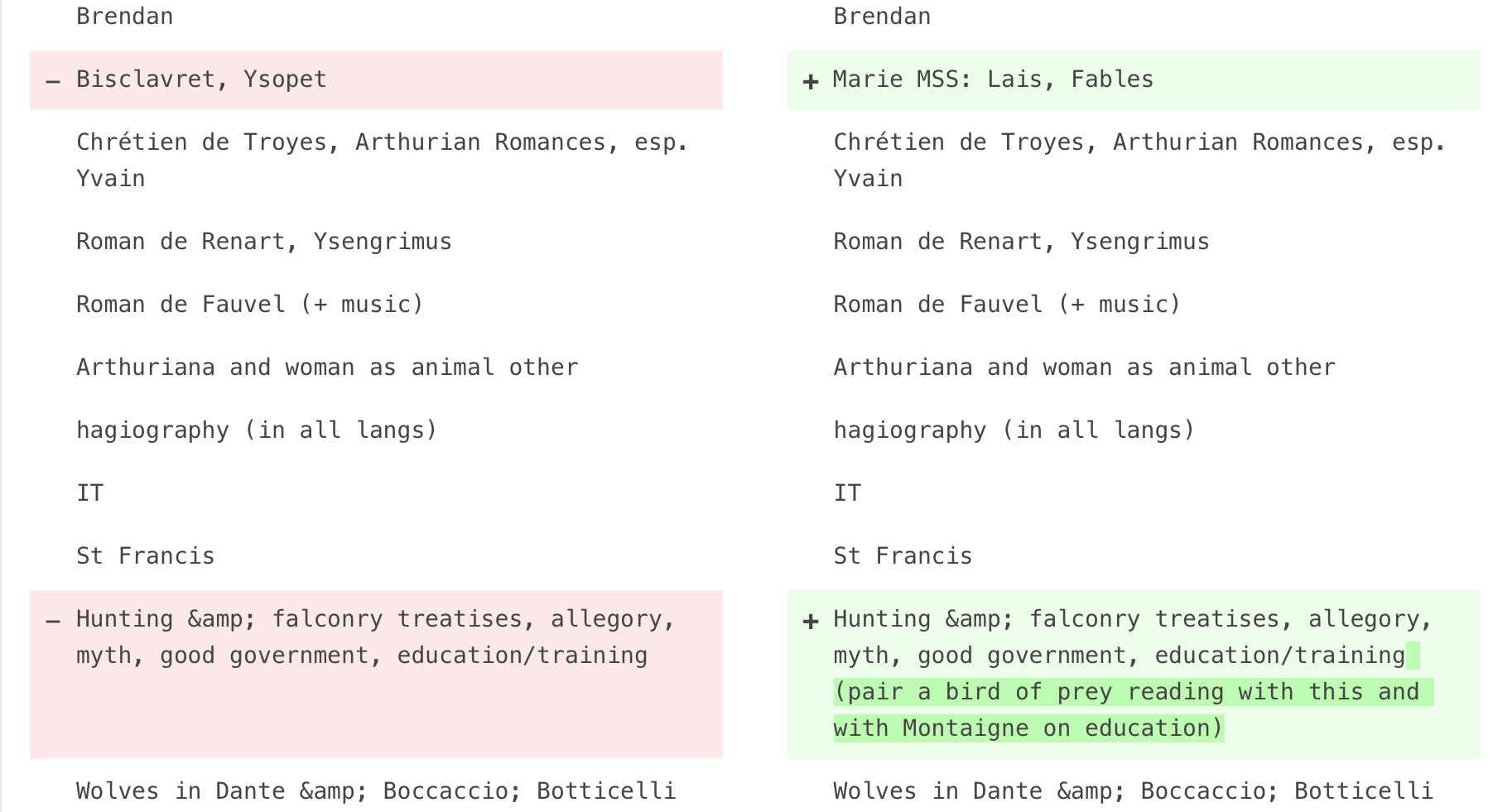
and when I started work on the bestiography in October, I moved some secondary readings into it that were originally at the end of this present page.
You can see, for example, that I was still mainly thinking about “reading animals” as principally being “reading about animals represented as characters or otherwise making appearances in written texts”; I was starting to think in bestiary mode, trying to include as many animals as possible in the course. There was a separate planning stage in which I worried about the order in which animals should appear, with the idea that the course structure, as a linear narrative, should replicate that of bestiary or other big book of knowledge in which animals feature. These books, of course, are not linear; and there is no good humanimal reason why a course should be either. (This was foolish. I’ve been working on poetry and nonlinear narrative for decades. I designed the course around student independent final projects rather than towards a final exam. I should know better.)
There are ideas in the list above that influenced the course of the course: about translation, metamorphosis, shape-shifting; about texts as living things themselves, as creatures inhabiting the books they’re in, and these larger books and libraries as environments; about collections, miscellanies, and encyclopaedias as worlds; about different kinds of “animal reading”: humans reading animals, animals reading humans, humans reading themselves as human through reading animals, humans reading themselves as animal through reading animals, beings that change category or move from one to the other or are between them or are more than one (or all of these), humans as animals who read and who read other fellow humans in these old books from far away as animals and other alien life-forms; about books as—if you’ll forgive the creation of a monstrous hybrid—distant mirrors for princes.
What happened between July and November? I read the André Miquel translation of Kalila and Dimna and the Chandra Rajan translation of the Pancatantra. I was thinking about collections, episodic narrative, books with frame narratives, compilations, miscellanies, as whole literary worlds. I was reading a lot of digitised manuscripts online, including fables (via Marie de France) and bestiaries. And so I added more bestiariness to the course, adding students’ local public bestiary work; its “local” aspect seemed to me to be important. Important to an idea of us, as individuals and as a community constructed in and through the course, being creatures within a metaphorical bestiary. Important to students being individuals with their own world and senses of what “the local” was for them; just as one of my own locals, the place that you’re seeing in this list here above, is medieval Romance literature. As a result, my list of supplementary readings couldn’t possibly be a list of supplementary readings; it and its world were far too limited. Inappropriately circumscriptive; closing off when the intention was to open up. It changed from being a prescriptive list for others’ reading and work, to being a descriptive list of my own; describing one particular reading animal’s habitat, what was “local” for it; at the same time, giving some insight into this present reading animal.
The course was shifting from being one about humans reading animals, to one about humans as reading animals, and not just in any of the expected senses (within Romance and European literary and literary critical traditions) of characteristics that define humans as different from animals: memory, reasoning, Aristotle’s “the mind that is what it is because it can become all things,” Huizinga’s homo ludens of laughter and play, creativity, poiesis, mythopoiesis. Reading this page now in November, there’s a reading animal here who’s a creature about and of and in reading.
So this page would be a bestiary entry about a reading animal. Me.
But that’s not all that’s going on here. “Reading” is books, the worlds that they contain, and the bookish world that they are. It’s also dynamic: inhabiting that world and shaping and making it through the living active practice of reading. One way to do so is designing and teaching a course. It might have seemed, some months ago, that this course was my creation and my creature. It soon became clear that the course was alive: it grew, suggesting that it had a vegetative soul, plant-like in a rough version of the terms of Arisotle’s De anima. Over the last three months, while I was teaching, the course moved and responded to sensation, looking like it had an animal-like sensitive soul. And now at its end the course seems to be thinking and showing signs of having a rational soul.
It’s changed. I’ve changed (this is the “me on 26 November 2019” speaking). I’m no longer so sure that this course is my creature, or if I am its creature; whether the course is this reading animal’s environment, or we’re both part of something bigger; where one of us ends and another begins; and, insofar as we can distinguish and separate one of us from the other, what our relationship is to one another. We might seem, superficially, like different species; but Aristotle’s are not the only criteria and besides, there are less rough, subtler, ways to read these criteria. We’re certainly kith. Thinking about it, we’re also kin. We’re related, the course and I, as offspring of The Draft Resources Creature.
It is an animal that read us into being. It is an essentially mutable being, open-ended, continuing, generating others, resistant to being closed off and finished and fixed. It’s part of the family of bibliographies. They are all marvels and monstrously infinite and infinitely monstrous; in positive ways too, through these words’ deeper etymological roots and spreading associative branches. Like all bibliographies, it is an omnivore. It is always full yet always hungry. It eats constantly, sailing whale-like open-mouthed. (If you are consumed by it, it won’t hurt; you’ll drift off into a fog, glaze over, turn ambergris-like jewel, and live forever as part of The Draft Resources Creature’s glorious decoration.) It shares many more familiar creatures’ features, like whalishness, and those of plants and lands and vapours as it’s also related to the aspidochelone that floats internationally and multilingually around the the 8th-12th-c. Brendan immram-cum-navigatio.
Like all bibliographies, its most marvellous characteristic is that it transcends mere amphibiousness. It is panbious: a cosmopolitan living in all places and times and dimensions, yet tied to none of them; ever curious in its wanderings, and always welcome in new places as it has no interest in settling and lording; giving—fruit, nectar, wine, milk and honey, precious jewels and other puns, ideas, perfume, pomegranate seeds—as much as it takes, generously and naturally and wisely; and giving truly: without keeping tally, score, or accounts. It is prone to digression, blown off-course and into new currents and trains of thought with chance gusts, gliding on thermals, circling back when the wind changes to knock you over with an Arctic blast through the tiniest chink in what you thought was a firmly-closed door. Drafty and draughty, it is potentially infinitely long-winded.
So this page is also an entry in our local public bestiary of humanimals reading. The Draft Resources Creature, a reading animal.
